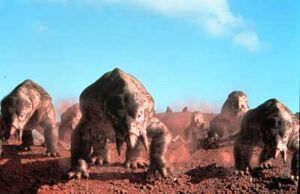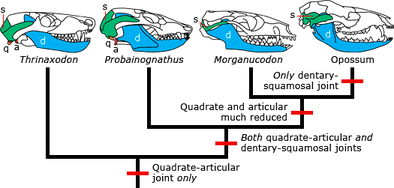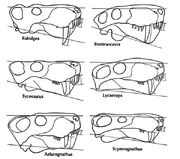
Herd of Placerias, dicynodont therapsids
Therapsids (Therapsida) are the synapsid animals with more erect limbs than the earlier synapsid "pelycosaurs" like Dimetrodon or Edaphosaurus, that had sprawling gait similar to lizards. Therapsids also have more complex teeth than the earlier synapsids.
Therapsids, reptiles and mammals
First therapsids and earlier synapsids were somewhat reptile-like but later therapsids were more mammal-like. Therapsids other than mammals and the "pelycosaurs" were once called "mammal-like reptiles", but the name is somewhat misleading because they are not reptiles in the true sence.
All therapsids are closer to mammals than any reptiles and it is long known that mammals are the only surviving descendants of the therapsid lineage called cynodonts. That is the reason why modern taxonomy includes mammals in Therapsida.

Therapsid evolution
Modern mammals only have one bone in their lower-jaw called dentary when other land vertebrates like crocodiles and lizards have several bones (dentary, articular, etc.). In the evolution of therapsids, the jaw-joint bones quadrate and articular became middle ear bones of mammals, "anvil" (incus) and "hammer" (malleus).
The synapsid type holes behind the eye hole for jaw muscles in the skull of therapsids became the zygomatic arch seen in the skulls of modern mammals.
Therapsid times
Therapsids ruled the Earth before the time of dinosaurs, and as form of mammals they also did after the dinosaurs other than birds went extinct at the end of Cretaceous period.
Most therapsids went extinct at the end of the Permian period that wasn't long before first dinosaurs appeared in Mid epoc of the Triassic. This end Permian extinction was the greatest known dying event in the Earth's history and almost all life died at the time. Because of thi the Permian-Triassic extinction is also called as the "Great Dying".
During the earliest Triassic the surviving therapsids were still doing quite well. Lystrosaurus for example was the most common vertebrate land animal of it's time. But soon therapsids lost their power when crocodlie related reptiles became larger and more ferocious.
Large therapsids like Placerias became less common during these times. Also in the Late Triassic dinosaurs took over the world from their croc-like relatives and became the rulers of the world. In the following dinosaur times mammals and other surviving therapsids were usually very small.
Last therapsids that were not mammals, the cynodont group known as tritylodontids disappeared in Early Cretaceous about 100 million years ago.
The rise of dinosaurs and their crocodile-like relatives is likely due to the fact that all the large therapsids died in the Permian-Triassic extinction. And dinosaurs were adaptable animals able to exploit the empty niches left from the extinct therapsids.
Therapsid groups and characteristics

Gorgonopsian therapsid skulls
There were many differend types of therapsids. Some of them like the dicynodonts were plant eaters. Others like gorgonopsids were fearsome predators.
Some characteristics of therapsids:
- Skull bone features
- Enlarged temporal fenestra (hole for jaw muscles behind the hole for eye)
- maxilla bone (upper jaw bone with teeth) enlarged, separating nasal & lacrimal bones
- quadrate (bone near upper jaw joint) reduced, dentary (outer lower jaw bone)anteriorly expanded
- Other features
- more than 3 sacral vertebrae
Therapsid groups:
- Raranimus (a very primitive therapsid)
- Biarmosuchia
- Biarmosuchidae
- Burnetiamorpha (seveal horns and protuberances at head)
- Dinocephalia (therapsids with thickened skull, meat and plant eaters) (NOTE: They have nothing to do with dinosaurs.)
- Anteosauria (meat eaters)
- Tapinocephalia (mostly plant eaters)
- Estemmenosuchidae (horned dinocephalians)
- Tapinocephalidae (Moschops etc.)
- Titanosuchidae
- Anomodontia (mostly plant eaters)
- Venyukovioidea
- Dicynodontia (beaked two-tusked plant eaters)
- Theriodontia
- Gorgonopsia (saber-toothed predators)
- Therocephalia
- Scylacosauridae
- Whaitsiidae
- Baurioidea
- Cynodontia
- Cynognathia
- Probainognathia
- Tritylodontidae (tritylodontids)
- Mammalia (mammals)
A synapsid called Tetraceratops is classified as a therapsid by some but others think that it does not have enough in common with the proper therapsids. Tetraceratops is known only from one skull so all of it's characteristics are not known. Anyway it was closely related to therapsids if it was not one of them.





